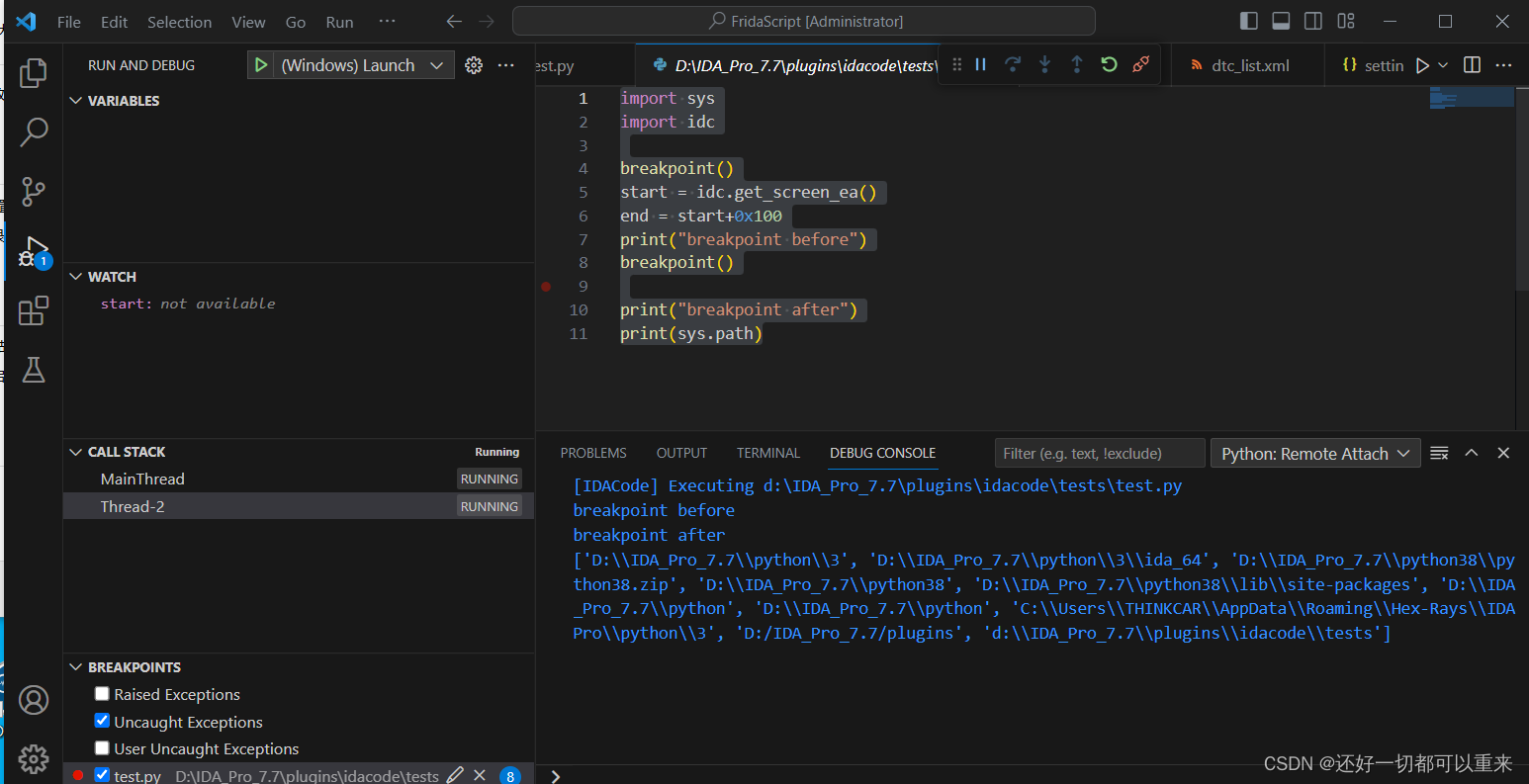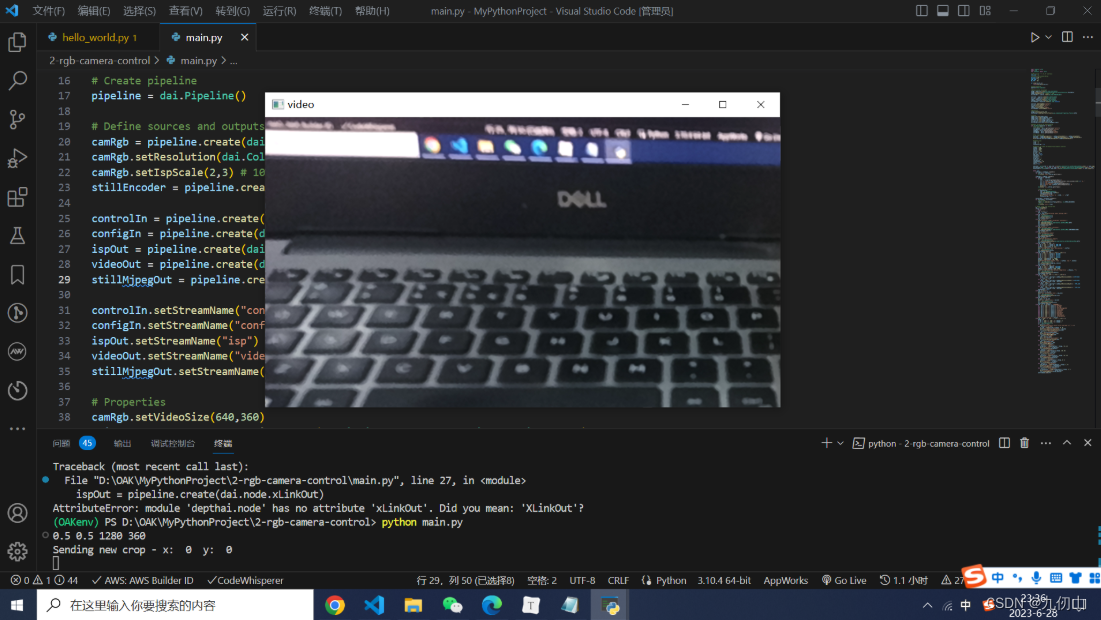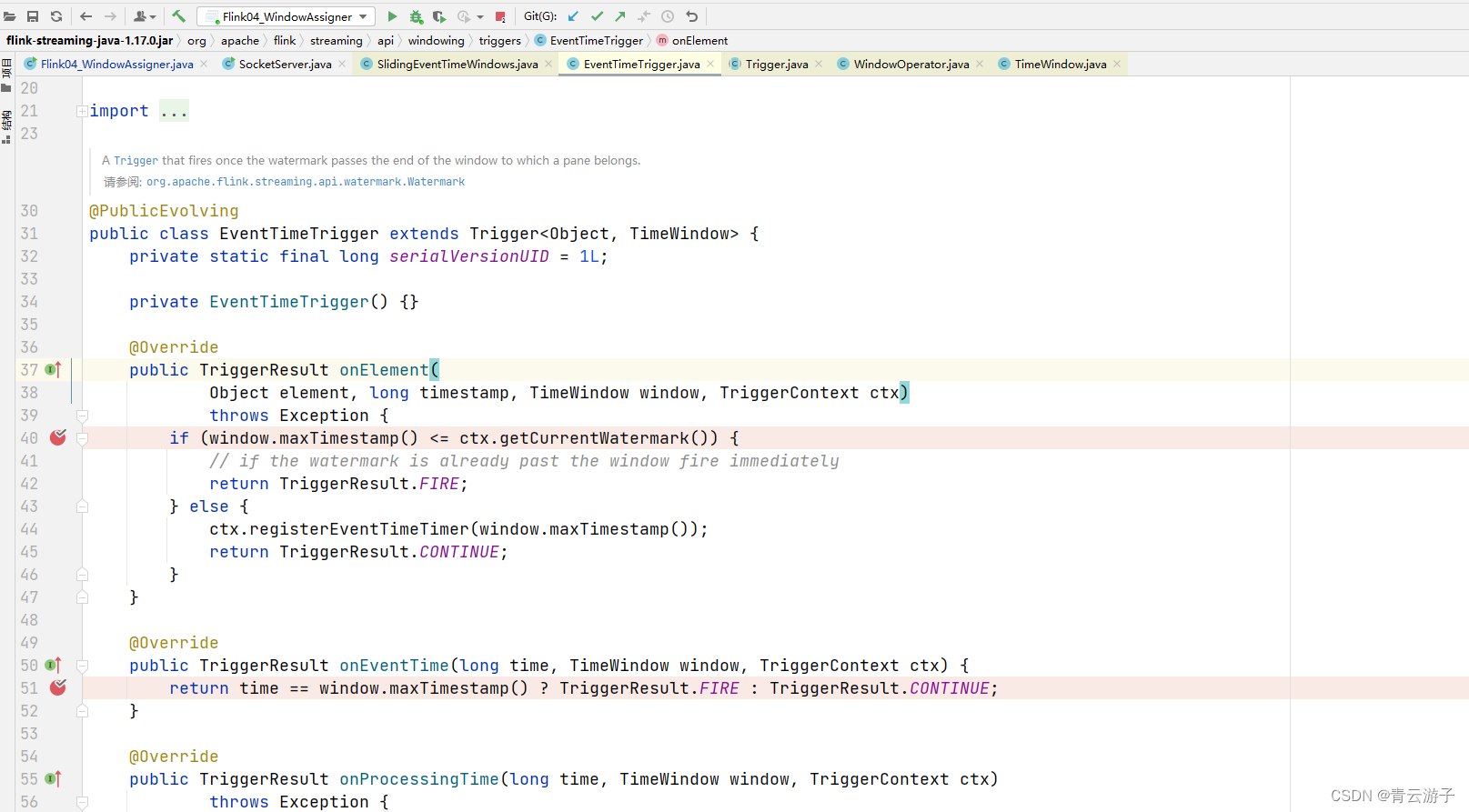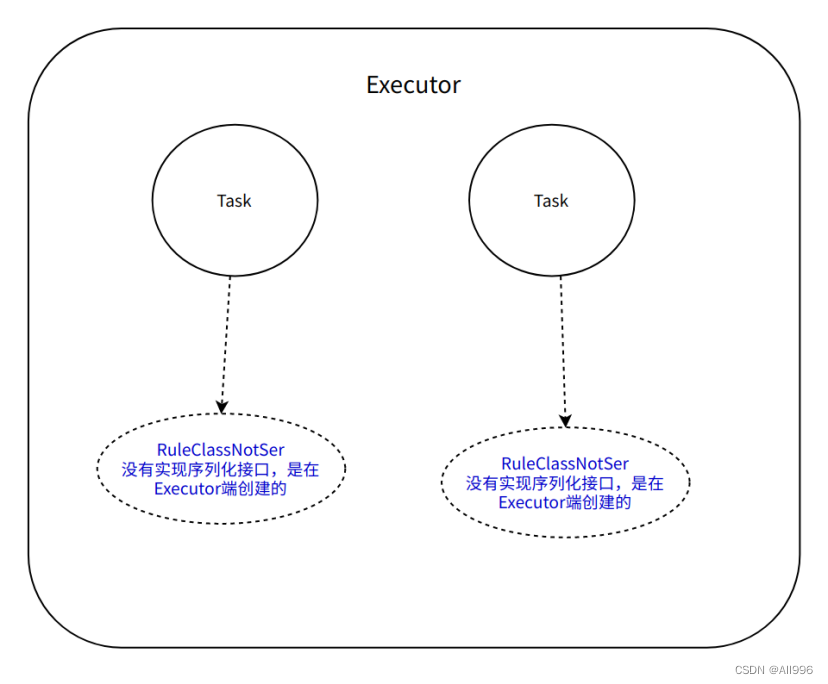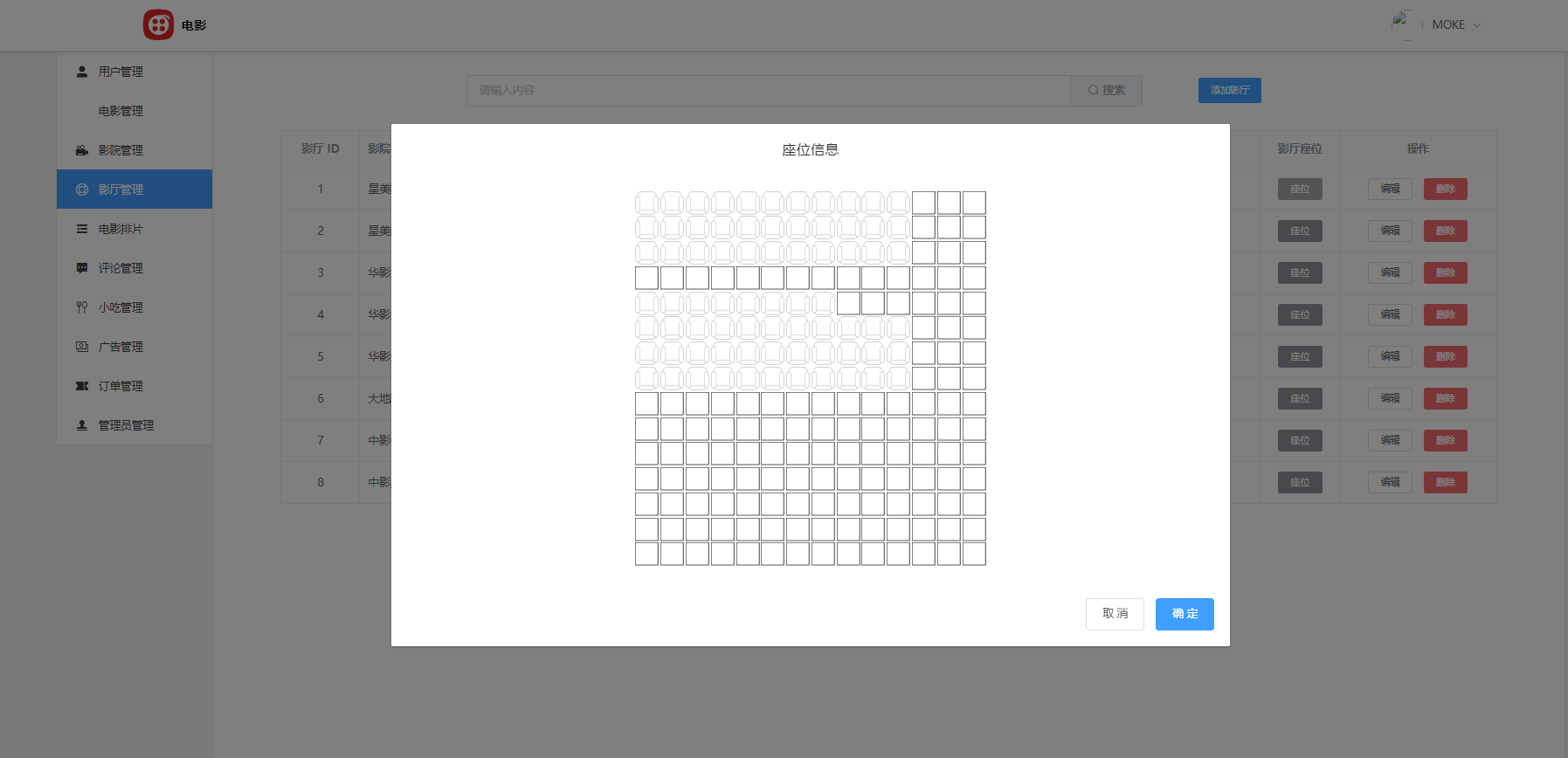介绍
用一个变量如何维护多种状态 在 ReentrantLock 中,使用 Sync ( 实际是 AQS )的 int 类型的 state 来表示同步状态,表示锁被一个线程重复获取的次数。
但是,读写锁 ReentrantReadWriteLock 内部维护着一对读写锁,如果要用一个变量维护多种状态,需要采用“按位切割使用”的方式来维护这个变量,将其切分为两部分:高16为表示读,低16为表示写。
分割之后,读写锁是如何迅速确定读锁和写锁的状态呢?通过位运算。假如当前同步状态为S,那么:
写状态,等于 S & 0x0000FFFF(将高 16 位全部抹去)。 当写状态加1,等于S+1.
读状态,等于 S >>> 16 (无符号补 0 右移 16 位)。当读状态加1,等于S+(1<<16),也就是S+0x00010000
根据状态的划分能得出一个推论:S不等于0时,当写状态(S&0x0000FFFF)等于0时,则读状态(S>>>16)大于0,即读锁已被获取。

public class ReentrantReadWriteLockimplements ReadWriteLock, java.io.Serializable
常量&变量
//序列化版本号private static final long serialVersionUID = -6992448646407690164L;/** Inner class providing readlock *///读锁private final ReentrantReadWriteLock.ReadLock readerLock;/** Inner class providing writelock *///写锁private final ReentrantReadWriteLock.WriteLock writerLock;/** Performs all synchronization mechanics *///同步器final Sync sync;// Unsafe mechanicsprivate static final sun.misc.Unsafe UNSAFE;private static final long TID_OFFSET;static {try {UNSAFE = sun.misc.Unsafe.getUnsafe();Class<?> tk = Thread.class;TID_OFFSET = UNSAFE.objectFieldOffset(tk.getDeclaredField("tid"));} catch (Exception e) {throw new Error(e);}}
内部类
Sync
ReentrantReadWriteLock将状态码state分为高16位和低16位。状态码state的高16位用于存储并发读取的线程数(读线程重入的次数也加入计数),即状态码state的高16位=(线程1的重入次数+线程2的重入次数+…+线程n的重入次数)。状态码state的低16位用于存储单个写线程的重入次数(写锁为互斥锁,只有一个线程能获取写锁)。
/*** Synchronization implementation for ReentrantReadWriteLock.* Subclassed into fair and nonfair versions.*/abstract static class Sync extends AbstractQueuedSynchronizer {//版本序列号private static final long serialVersionUID = 6317671515068378041L;/** Read vs write count extraction constants and functions.* Lock state is logically divided into two unsigned shorts:* The lower one representing the exclusive (writer) lock hold count,* and the upper the shared (reader) hold count.*/// 共享锁偏移量 state共32位 高16位为读锁,低16位为写锁static final int SHARED_SHIFT = 16;//高16位,用于存储并发读取的线程数 00000000 00000001 00000000 00000000static final int SHARED_UNIT = (1 << SHARED_SHIFT);//持有读锁的读线程的最大数量 00000000 00000000 11111111 11111111即65535static final int MAX_COUNT = (1 << SHARED_SHIFT) - 1;//用于计算低16位的单个写进程重入次数 00000000 00000000 11111111 11111111static final int EXCLUSIVE_MASK = (1 << SHARED_SHIFT) - 1;/** Returns the number of shared holds represented in count *///计算共享的数量(读锁) 高16位表示。// 读锁可以同时被多个线程持有,每个线程持有的读锁支持重入的特性,所以需要对每个线程持有的读锁的数量单独计数,这就需要用到 HoldCounter 计数器static int sharedCount(int c) { return c >>> SHARED_SHIFT; }/** Returns the number of exclusive holds represented in count *///计算独占的重入数量(写锁):低16位表示。static int exclusiveCount(int c) { return c & EXCLUSIVE_MASK; }/*** A counter for per-thread read hold counts.* Maintained as a ThreadLocal; cached in cachedHoldCounter*//*** 读锁的本质是共享锁,一次共享锁的操作就相当于对HoldCounter 计数器的操作。* 获取共享锁,则该计数器 + 1,释放共享锁,该计数器 - 1。只有当线程获取共享锁后才能对共享锁进行释放、重入操作。* HoldCounter是用来记录读锁重入数的对象*/static final class HoldCounter {int count = 0;// Use id, not reference, to avoid garbage retentionfinal long tid = getThreadId(Thread.currentThread());}/*** ThreadLocal subclass. Easiest to explicitly define for sake* of deserialization mechanics.*//*** 通过 ThreadLocalHoldCounter 类,HoldCounter 与线程进行绑定。* HoldCounter 是绑定线程的一个计数器,而 ThreadLocalHoldCounter 则是线程绑定的 ThreadLocal。* ThreadLocalHoldCounter是ThreadLocal变量,用来存放不是第一个获取读锁的线程的其他线程的读锁重入数对象*/static final class ThreadLocalHoldCounterextends ThreadLocal<HoldCounter> {public HoldCounter initialValue() {return new HoldCounter();}}/*** The number of reentrant read locks held by current thread.* Initialized only in constructor and readObject.* Removed whenever a thread's read hold count drops to 0.*/private transient ThreadLocalHoldCounter readHolds;/*** The hold count of the last thread to successfully acquire* readLock. This saves ThreadLocal lookup in the common case* where the next thread to release is the last one to* acquire. This is non-volatile since it is just used* as a heuristic, and would be great for threads to cache.** <p>Can outlive the Thread for which it is caching the read* hold count, but avoids garbage retention by not retaining a* reference to the Thread.** <p>Accessed via a benign data race; relies on the memory* model's final field and out-of-thin-air guarantees.*/private transient HoldCounter cachedHoldCounter;/*** firstReader is the first thread to have acquired the read lock.* firstReaderHoldCount is firstReader's hold count.** <p>More precisely, firstReader is the unique thread that last* changed the shared count from 0 to 1, and has not released the* read lock since then; null if there is no such thread.** <p>Cannot cause garbage retention unless the thread terminated* without relinquishing its read locks, since tryReleaseShared* sets it to null.** <p>Accessed via a benign data race; relies on the memory* model's out-of-thin-air guarantees for references.** <p>This allows tracking of read holds for uncontended read* locks to be very cheap.*/private transient Thread firstReader = null;private transient int firstReaderHoldCount;Sync() {readHolds = new ThreadLocalHoldCounter();setState(getState()); // ensures visibility of readHolds}/** Acquires and releases use the same code for fair and* nonfair locks, but differ in whether/how they allow barging* when queues are non-empty.*//*** Returns true if the current thread, when trying to acquire* the read lock, and otherwise eligible to do so, should block* because of policy for overtaking other waiting threads.*/abstract boolean readerShouldBlock();/*** Returns true if the current thread, when trying to acquire* the write lock, and otherwise eligible to do so, should block* because of policy for overtaking other waiting threads.*/abstract boolean writerShouldBlock();/** Note that tryRelease and tryAcquire can be called by* Conditions. So it is possible that their arguments contain* both read and write holds that are all released during a* condition wait and re-established in tryAcquire.*/protected final boolean tryRelease(int releases) {//若锁的持有者不是当前线程,抛出异常if (!isHeldExclusively())throw new IllegalMonitorStateException();//state的预期值int nextc = getState() - releases;//当前写状态是否为0,为0则释放写锁boolean free = exclusiveCount(nextc) == 0;//当前写状态为0if (free)//设置锁的持有者为nullsetExclusiveOwnerThread(null);//同步状态statesetState(nextc);return free;}protected final boolean tryAcquire(int acquires) {/** Walkthrough:* 1. If read count nonzero or write count nonzero* and owner is a different thread, fail.* 2. If count would saturate, fail. (This can only* happen if count is already nonzero.)* 3. Otherwise, this thread is eligible for lock if* it is either a reentrant acquire or* queue policy allows it. If so, update state* and set owner.*///当前线程Thread current = Thread.currentThread();//aqs的state值 存在读锁或者写锁,状态就不为0int c = getState();//获取写锁的重入数int w = exclusiveCount(c);//当前同步状态state != 0,说明已经有其他线程获取了读锁或写锁if (c != 0) {// (Note: if c != 0 and w == 0 then shared count != 0)// c!=0 && w==0 表示存在读锁// 当前存在读锁或者写锁已经被其他写线程获取,则写锁获取失败if (w == 0 || current != getExclusiveOwnerThread())return false;//最大可重入次数 超出最大范围 65535if (w + exclusiveCount(acquires) > MAX_COUNT)throw new Error("Maximum lock count exceeded");// Reentrant acquire//同步state状态setState(c + acquires);return true;}// writerShouldBlock有公平与非公平的实现, 非公平返回false,会尝试通过cas加锁//c==0 写锁未被任何线程获取,当前线程是否阻塞或者cas尝试获取锁if (writerShouldBlock() ||!compareAndSetState(c, c + acquires))return false;//获取写锁成功 设置写锁为当前线程所有setExclusiveOwnerThread(current);return true;}protected final boolean tryReleaseShared(int unused) {Thread current = Thread.currentThread();//当前线程是第一个获取读锁的线程if (firstReader == current) {// assert firstReaderHoldCount > 0;// 第一个获取读锁的线程的重入次数为1if (firstReaderHoldCount == 1)//第一个获取对锁的线程为nullfirstReader = null;else//重入次数大于1,重入次数-1firstReaderHoldCount--;} else {//不是第一个获取读锁的线程HoldCounter rh = cachedHoldCounter;if (rh == null || rh.tid != getThreadId(current))//获取线程的计数器rh = readHolds.get();//重入次数int count = rh.count;//重入次数小于等于1 ,移除该线程的读锁if (count <= 1) {readHolds.remove();if (count <= 0)throw unmatchedUnlockException();}//重入次数大于1,计数器减1--rh.count;}for (;;) {int c = getState();int nextc = c - SHARED_UNIT;if (compareAndSetState(c, nextc))// Releasing the read lock has no effect on readers,// but it may allow waiting writers to proceed if// both read and write locks are now free.return nextc == 0;}}private IllegalMonitorStateException unmatchedUnlockException() {return new IllegalMonitorStateException("attempt to unlock read lock, not locked by current thread");}protected final int tryAcquireShared(int unused) {/** Walkthrough:* 1. If write lock held by another thread, fail.* 2. Otherwise, this thread is eligible for* lock wrt state, so ask if it should block* because of queue policy. If not, try* to grant by CASing state and updating count.* Note that step does not check for reentrant* acquires, which is postponed to full version* to avoid having to check hold count in* the more typical non-reentrant case.* 3. If step 2 fails either because thread* apparently not eligible or CAS fails or count* saturated, chain to version with full retry loop.*/Thread current = Thread.currentThread();int c = getState();// 如果写锁已经被获取并且获取写锁的线程不是当前线程,当前线程获取读锁失败返回-1 判断锁降级if (exclusiveCount(c) != 0 &&getExclusiveOwnerThread() != current)return -1;//读锁的数量int r = sharedCount(c);//获取读锁的线程是否该被阻塞if (!readerShouldBlock() &&r < MAX_COUNT &&compareAndSetState(c, c + SHARED_UNIT)) {//当前线程获取读锁//如果是第一个获取读锁的线程if (r == 0) {firstReader = current;firstReaderHoldCount = 1;//设置第一个获取读锁线程的重入数// 表示第一个获取读锁的线程重入} else if (firstReader == current) {//第一个获取读锁的线程重入次数+ 1firstReaderHoldCount++;} else {// 非第一个获取读锁的线程HoldCounter rh = cachedHoldCounter;if (rh == null || rh.tid != getThreadId(current))cachedHoldCounter = rh = readHolds.get();else if (rh.count == 0)readHolds.set(rh);//记录其他获取读锁的线程的重入次数rh.count++;}return 1;}//尝试通过自旋的方式获取读锁,实现了重入逻辑return fullTryAcquireShared(current);}/*** Full version of acquire for reads, that handles CAS misses* and reentrant reads not dealt with in tryAcquireShared.*/final int fullTryAcquireShared(Thread current) {/** This code is in part redundant with that in* tryAcquireShared but is simpler overall by not* complicating tryAcquireShared with interactions between* retries and lazily reading hold counts.*/HoldCounter rh = null;for (;;) {int c = getState();if (exclusiveCount(c) != 0) {if (getExclusiveOwnerThread() != current)return -1;// else we hold the exclusive lock; blocking here// would cause deadlock.} else if (readerShouldBlock()) {// Make sure we're not acquiring read lock reentrantlyif (firstReader == current) {// assert firstReaderHoldCount > 0;} else {if (rh == null) {rh = cachedHoldCounter;if (rh == null || rh.tid != getThreadId(current)) {rh = readHolds.get();if (rh.count == 0)readHolds.remove();}}if (rh.count == 0)return -1;}}if (sharedCount(c) == MAX_COUNT)throw new Error("Maximum lock count exceeded");if (compareAndSetState(c, c + SHARED_UNIT)) {if (sharedCount(c) == 0) {firstReader = current;firstReaderHoldCount = 1;} else if (firstReader == current) {firstReaderHoldCount++;} else {if (rh == null)rh = cachedHoldCounter;if (rh == null || rh.tid != getThreadId(current))rh = readHolds.get();else if (rh.count == 0)readHolds.set(rh);rh.count++;cachedHoldCounter = rh; // cache for release}return 1;}}}/*** Performs tryLock for write, enabling barging in both modes.* This is identical in effect to tryAcquire except for lack* of calls to writerShouldBlock.*/final boolean tryWriteLock() {Thread current = Thread.currentThread();int c = getState();if (c != 0) {int w = exclusiveCount(c);if (w == 0 || current != getExclusiveOwnerThread())return false;if (w == MAX_COUNT)throw new Error("Maximum lock count exceeded");}if (!compareAndSetState(c, c + 1))return false;setExclusiveOwnerThread(current);return true;}/*** Performs tryLock for read, enabling barging in both modes.* This is identical in effect to tryAcquireShared except for* lack of calls to readerShouldBlock.*/final boolean tryReadLock() {Thread current = Thread.currentThread();for (;;) {int c = getState();if (exclusiveCount(c) != 0 &&getExclusiveOwnerThread() != current)return false;int r = sharedCount(c);if (r == MAX_COUNT)throw new Error("Maximum lock count exceeded");if (compareAndSetState(c, c + SHARED_UNIT)) {if (r == 0) {firstReader = current;firstReaderHoldCount = 1;} else if (firstReader == current) {firstReaderHoldCount++;} else {HoldCounter rh = cachedHoldCounter;if (rh == null || rh.tid != getThreadId(current))cachedHoldCounter = rh = readHolds.get();else if (rh.count == 0)readHolds.set(rh);rh.count++;}return true;}}}protected final boolean isHeldExclusively() {// While we must in general read state before owner,// we don't need to do so to check if current thread is ownerreturn getExclusiveOwnerThread() == Thread.currentThread();}// Methods relayed to outer classfinal ConditionObject newCondition() {return new ConditionObject();}final Thread getOwner() {// Must read state before owner to ensure memory consistencyreturn ((exclusiveCount(getState()) == 0) ?null :getExclusiveOwnerThread());}final int getReadLockCount() {return sharedCount(getState());}final boolean isWriteLocked() {return exclusiveCount(getState()) != 0;}final int getWriteHoldCount() {return isHeldExclusively() ? exclusiveCount(getState()) : 0;}final int getReadHoldCount() {if (getReadLockCount() == 0)return 0;Thread current = Thread.currentThread();if (firstReader == current)return firstReaderHoldCount;HoldCounter rh = cachedHoldCounter;if (rh != null && rh.tid == getThreadId(current))return rh.count;int count = readHolds.get().count;if (count == 0) readHolds.remove();return count;}/*** Reconstitutes the instance from a stream (that is, deserializes it).*/private void readObject(java.io.ObjectInputStream s)throws java.io.IOException, ClassNotFoundException {s.defaultReadObject();readHolds = new ThreadLocalHoldCounter();setState(0); // reset to unlocked state}final int getCount() { return getState(); }}
NonfairSync
在NonfairSync类中,读锁和写锁都被实现为可重入锁。具体来说,它通过维护一个线程持有的读写锁数量来实现可重入性,因此一个线程可以多次获取读写锁而不会被阻塞。
另外,NonfairSync类中还有一些方法用于实现读写锁的获取、释放和降级等操作。其中最重要的方法是tryAcquireShared(int arg)和tryAcquire(int arg)方法,它们分别用于获取读锁和写锁。这些方法会根据当前锁的状态来判断线程是否可以获取锁,并且在获取锁的同时更新锁状态。
/*** Nonfair version of Sync* 非公平锁,继承Sync*/static final class NonfairSync extends Sync {private static final long serialVersionUID = -8159625535654395037L;final boolean writerShouldBlock() {return false; // writers can always barge}final boolean readerShouldBlock() {/* As a heuristic to avoid indefinite writer starvation,* block if the thread that momentarily appears to be head* of queue, if one exists, is a waiting writer. This is* only a probabilistic effect since a new reader will not* block if there is a waiting writer behind other enabled* readers that have not yet drained from the queue.*/return apparentlyFirstQueuedIsExclusive();}}
FairSync
在FairSync中,读写锁的获取是基于“先到先得”的原则,即先请求锁的线程先获得锁,保证了锁的获取是公平的。FairSync实现了公平性的方式是通过维护等待队列实现的,当有线程请求锁时,FairSync会将其添加到等待队列的尾部,当锁可用时,会从队列的头部选择一个线程获得锁。因此,FairSync在保证公平性的同时,可能会导致额外的上下文切换开销,影响锁的性能表现。
/*** Fair version of Sync* 公平锁,继承Sync*/static final class FairSync extends Sync {private static final long serialVersionUID = -2274990926593161451L;final boolean writerShouldBlock() {return hasQueuedPredecessors();}final boolean readerShouldBlock() {return hasQueuedPredecessors();}}
ReadLock
ReadLock是一个读锁,用于控制读取操作的并发访问。它实现了Lock接口中的lock()、unlock()方法,以及Condition接口中的newCondition()方法。
当一个线程获取了ReadLock之后,其他线程可以继续获取ReadLock,但不能获取WriteLock。只有当所有线程释放了ReadLock,才能有一个线程获取WriteLock。
使用ReentrantReadWriteLock可以提高程序的并发性能,因为它允许多个线程同时读取数据,但只允许一个线程写入数据,从而避免了读写冲突的问题。
/*** The lock returned by method {@link ReentrantReadWriteLock#readLock}.* 读锁*/public static class ReadLock implements Lock, java.io.Serializable {private static final long serialVersionUID = -5992448646407690164L;private final Sync sync;/*** Constructor for use by subclasses** @param lock the outer lock object* @throws NullPointerException if the lock is null*/protected ReadLock(ReentrantReadWriteLock lock) {sync = lock.sync;}/*** Acquires the read lock.** <p>Acquires the read lock if the write lock is not held by* another thread and returns immediately.** <p>If the write lock is held by another thread then* the current thread becomes disabled for thread scheduling* purposes and lies dormant until the read lock has been acquired.* 读锁加锁*/public void lock() {sync.acquireShared(1);}/*** Acquires the read lock unless the current thread is* {@linkplain Thread#interrupt interrupted}.** <p>Acquires the read lock if the write lock is not held* by another thread and returns immediately.** <p>If the write lock is held by another thread then the* current thread becomes disabled for thread scheduling* purposes and lies dormant until one of two things happens:** <ul>** <li>The read lock is acquired by the current thread; or** <li>Some other thread {@linkplain Thread#interrupt interrupts}* the current thread.** </ul>** <p>If the current thread:** <ul>** <li>has its interrupted status set on entry to this method; or** <li>is {@linkplain Thread#interrupt interrupted} while* acquiring the read lock,** </ul>** then {@link InterruptedException} is thrown and the current* thread's interrupted status is cleared.** <p>In this implementation, as this method is an explicit* interruption point, preference is given to responding to* the interrupt over normal or reentrant acquisition of the* lock.** @throws InterruptedException if the current thread is interrupted*/public void lockInterruptibly() throws InterruptedException {sync.acquireSharedInterruptibly(1);}/*** Acquires the read lock only if the write lock is not held by* another thread at the time of invocation.** <p>Acquires the read lock if the write lock is not held by* another thread and returns immediately with the value* {@code true}. Even when this lock has been set to use a* fair ordering policy, a call to {@code tryLock()}* <em>will</em> immediately acquire the read lock if it is* available, whether or not other threads are currently* waiting for the read lock. This "barging" behavior* can be useful in certain circumstances, even though it* breaks fairness. If you want to honor the fairness setting* for this lock, then use {@link #tryLock(long, TimeUnit)* tryLock(0, TimeUnit.SECONDS) } which is almost equivalent* (it also detects interruption).** <p>If the write lock is held by another thread then* this method will return immediately with the value* {@code false}.** @return {@code true} if the read lock was acquired*/public boolean tryLock() {return sync.tryReadLock();}/*** Acquires the read lock if the write lock is not held by* another thread within the given waiting time and the* current thread has not been {@linkplain Thread#interrupt* interrupted}.** <p>Acquires the read lock if the write lock is not held by* another thread and returns immediately with the value* {@code true}. If this lock has been set to use a fair* ordering policy then an available lock <em>will not</em> be* acquired if any other threads are waiting for the* lock. This is in contrast to the {@link #tryLock()}* method. If you want a timed {@code tryLock} that does* permit barging on a fair lock then combine the timed and* un-timed forms together:** <pre> {@code* if (lock.tryLock() ||* lock.tryLock(timeout, unit)) {* ...* }}</pre>** <p>If the write lock is held by another thread then the* current thread becomes disabled for thread scheduling* purposes and lies dormant until one of three things happens:** <ul>** <li>The read lock is acquired by the current thread; or** <li>Some other thread {@linkplain Thread#interrupt interrupts}* the current thread; or** <li>The specified waiting time elapses.** </ul>** <p>If the read lock is acquired then the value {@code true} is* returned.** <p>If the current thread:** <ul>** <li>has its interrupted status set on entry to this method; or** <li>is {@linkplain Thread#interrupt interrupted} while* acquiring the read lock,** </ul> then {@link InterruptedException} is thrown and the* current thread's interrupted status is cleared.** <p>If the specified waiting time elapses then the value* {@code false} is returned. If the time is less than or* equal to zero, the method will not wait at all.** <p>In this implementation, as this method is an explicit* interruption point, preference is given to responding to* the interrupt over normal or reentrant acquisition of the* lock, and over reporting the elapse of the waiting time.** @param timeout the time to wait for the read lock* @param unit the time unit of the timeout argument* @return {@code true} if the read lock was acquired* @throws InterruptedException if the current thread is interrupted* @throws NullPointerException if the time unit is null*/public boolean tryLock(long timeout, TimeUnit unit)throws InterruptedException {return sync.tryAcquireSharedNanos(1, unit.toNanos(timeout));}/*** Attempts to release this lock.** <p>If the number of readers is now zero then the lock* is made available for write lock attempts.* 读锁解锁*/public void unlock() {sync.releaseShared(1);}/*** Throws {@code UnsupportedOperationException} because* {@code ReadLocks} do not support conditions.** @throws UnsupportedOperationException always*/public Condition newCondition() {throw new UnsupportedOperationException();}/*** Returns a string identifying this lock, as well as its lock state.* The state, in brackets, includes the String {@code "Read locks ="}* followed by the number of held read locks.** @return a string identifying this lock, as well as its lock state*/public String toString() {int r = sync.getReadLockCount();return super.toString() +"[Read locks = " + r + "]";}}
WriteLock
WriteLock是一个可重入的独占锁,用于写操作的同步。该锁可以被多个读线程同时持有,但只能被一个写线程持有。如果试图在没有释放该锁的情况下重复获取WriteLock锁,则当前线程将一直被阻塞,直到锁被释放。
WriteLock对象可以通过调用ReentrantReadWriteLock的writeLock()方法来获取。获取WriteLock锁后,可以使用lock()方法进行锁定,使用unlock()方法进行解锁。和其他锁一样,为了避免死锁,建议在finally块中进行解锁操作。
WriteLock还提供了一些其他的方法,例如tryLock()方法尝试获取锁并立即返回结果,tryLock(long timeout, TimeUnit unit)方法尝试在指定时间内获取锁并返回结果。此外,WriteLock还可以通过调用getHoldCount()方法获取当前线程持有锁的数量,以支持可重入性。
/*** The lock returned by method {@link ReentrantReadWriteLock#writeLock}.* 写锁*/public static class WriteLock implements Lock, java.io.Serializable {private static final long serialVersionUID = -4992448646407690164L;private final Sync sync;/*** Constructor for use by subclasses** @param lock the outer lock object* @throws NullPointerException if the lock is null*/protected WriteLock(ReentrantReadWriteLock lock) {sync = lock.sync;}/*** Acquires the write lock.** <p>Acquires the write lock if neither the read nor write lock* are held by another thread* and returns immediately, setting the write lock hold count to* one.** <p>If the current thread already holds the write lock then the* hold count is incremented by one and the method returns* immediately.** <p>If the lock is held by another thread then the current* thread becomes disabled for thread scheduling purposes and* lies dormant until the write lock has been acquired, at which* time the write lock hold count is set to one.* 写锁加锁*/public void lock() {sync.acquire(1);}/*** Acquires the write lock unless the current thread is* {@linkplain Thread#interrupt interrupted}.** <p>Acquires the write lock if neither the read nor write lock* are held by another thread* and returns immediately, setting the write lock hold count to* one.** <p>If the current thread already holds this lock then the* hold count is incremented by one and the method returns* immediately.** <p>If the lock is held by another thread then the current* thread becomes disabled for thread scheduling purposes and* lies dormant until one of two things happens:** <ul>** <li>The write lock is acquired by the current thread; or** <li>Some other thread {@linkplain Thread#interrupt interrupts}* the current thread.** </ul>** <p>If the write lock is acquired by the current thread then the* lock hold count is set to one.** <p>If the current thread:** <ul>** <li>has its interrupted status set on entry to this method;* or** <li>is {@linkplain Thread#interrupt interrupted} while* acquiring the write lock,** </ul>** then {@link InterruptedException} is thrown and the current* thread's interrupted status is cleared.** <p>In this implementation, as this method is an explicit* interruption point, preference is given to responding to* the interrupt over normal or reentrant acquisition of the* lock.** @throws InterruptedException if the current thread is interrupted*/public void lockInterruptibly() throws InterruptedException {sync.acquireInterruptibly(1);}/*** Acquires the write lock only if it is not held by another thread* at the time of invocation.** <p>Acquires the write lock if neither the read nor write lock* are held by another thread* and returns immediately with the value {@code true},* setting the write lock hold count to one. Even when this lock has* been set to use a fair ordering policy, a call to* {@code tryLock()} <em>will</em> immediately acquire the* lock if it is available, whether or not other threads are* currently waiting for the write lock. This "barging"* behavior can be useful in certain circumstances, even* though it breaks fairness. If you want to honor the* fairness setting for this lock, then use {@link* #tryLock(long, TimeUnit) tryLock(0, TimeUnit.SECONDS) }* which is almost equivalent (it also detects interruption).** <p>If the current thread already holds this lock then the* hold count is incremented by one and the method returns* {@code true}.** <p>If the lock is held by another thread then this method* will return immediately with the value {@code false}.** @return {@code true} if the lock was free and was acquired* by the current thread, or the write lock was already held* by the current thread; and {@code false} otherwise.*/public boolean tryLock( ) {return sync.tryWriteLock();}/*** Acquires the write lock if it is not held by another thread* within the given waiting time and the current thread has* not been {@linkplain Thread#interrupt interrupted}.** <p>Acquires the write lock if neither the read nor write lock* are held by another thread* and returns immediately with the value {@code true},* setting the write lock hold count to one. If this lock has been* set to use a fair ordering policy then an available lock* <em>will not</em> be acquired if any other threads are* waiting for the write lock. This is in contrast to the {@link* #tryLock()} method. If you want a timed {@code tryLock}* that does permit barging on a fair lock then combine the* timed and un-timed forms together:** <pre> {@code* if (lock.tryLock() ||* lock.tryLock(timeout, unit)) {* ...* }}</pre>** <p>If the current thread already holds this lock then the* hold count is incremented by one and the method returns* {@code true}.** <p>If the lock is held by another thread then the current* thread becomes disabled for thread scheduling purposes and* lies dormant until one of three things happens:** <ul>** <li>The write lock is acquired by the current thread; or** <li>Some other thread {@linkplain Thread#interrupt interrupts}* the current thread; or** <li>The specified waiting time elapses** </ul>** <p>If the write lock is acquired then the value {@code true} is* returned and the write lock hold count is set to one.** <p>If the current thread:** <ul>** <li>has its interrupted status set on entry to this method;* or** <li>is {@linkplain Thread#interrupt interrupted} while* acquiring the write lock,** </ul>** then {@link InterruptedException} is thrown and the current* thread's interrupted status is cleared.** <p>If the specified waiting time elapses then the value* {@code false} is returned. If the time is less than or* equal to zero, the method will not wait at all.** <p>In this implementation, as this method is an explicit* interruption point, preference is given to responding to* the interrupt over normal or reentrant acquisition of the* lock, and over reporting the elapse of the waiting time.** @param timeout the time to wait for the write lock* @param unit the time unit of the timeout argument** @return {@code true} if the lock was free and was acquired* by the current thread, or the write lock was already held by the* current thread; and {@code false} if the waiting time* elapsed before the lock could be acquired.** @throws InterruptedException if the current thread is interrupted* @throws NullPointerException if the time unit is null*/public boolean tryLock(long timeout, TimeUnit unit)throws InterruptedException {return sync.tryAcquireNanos(1, unit.toNanos(timeout));}/*** Attempts to release this lock.** <p>If the current thread is the holder of this lock then* the hold count is decremented. If the hold count is now* zero then the lock is released. If the current thread is* not the holder of this lock then {@link* IllegalMonitorStateException} is thrown.** @throws IllegalMonitorStateException if the current thread does not* hold this lock* 写锁解锁*/public void unlock() {sync.release(1);}/*** Returns a {@link Condition} instance for use with this* {@link Lock} instance.* <p>The returned {@link Condition} instance supports the same* usages as do the {@link Object} monitor methods ({@link* Object#wait() wait}, {@link Object#notify notify}, and {@link* Object#notifyAll notifyAll}) when used with the built-in* monitor lock.** <ul>** <li>If this write lock is not held when any {@link* Condition} method is called then an {@link* IllegalMonitorStateException} is thrown. (Read locks are* held independently of write locks, so are not checked or* affected. However it is essentially always an error to* invoke a condition waiting method when the current thread* has also acquired read locks, since other threads that* could unblock it will not be able to acquire the write* lock.)** <li>When the condition {@linkplain Condition#await() waiting}* methods are called the write lock is released and, before* they return, the write lock is reacquired and the lock hold* count restored to what it was when the method was called.** <li>If a thread is {@linkplain Thread#interrupt interrupted} while* waiting then the wait will terminate, an {@link* InterruptedException} will be thrown, and the thread's* interrupted status will be cleared.** <li> Waiting threads are signalled in FIFO order.** <li>The ordering of lock reacquisition for threads returning* from waiting methods is the same as for threads initially* acquiring the lock, which is in the default case not specified,* but for <em>fair</em> locks favors those threads that have been* waiting the longest.** </ul>** @return the Condition object*/public Condition newCondition() {return sync.newCondition();}/*** Returns a string identifying this lock, as well as its lock* state. The state, in brackets includes either the String* {@code "Unlocked"} or the String {@code "Locked by"}* followed by the {@linkplain Thread#getName name} of the owning thread.** @return a string identifying this lock, as well as its lock state*/public String toString() {Thread o = sync.getOwner();return super.toString() + ((o == null) ?"[Unlocked]" :"[Locked by thread " + o.getName() + "]");}/*** Queries if this write lock is held by the current thread.* Identical in effect to {@link* ReentrantReadWriteLock#isWriteLockedByCurrentThread}.** @return {@code true} if the current thread holds this lock and* {@code false} otherwise* @since 1.6*/public boolean isHeldByCurrentThread() {return sync.isHeldExclusively();}/*** Queries the number of holds on this write lock by the current* thread. A thread has a hold on a lock for each lock action* that is not matched by an unlock action. Identical in effect* to {@link ReentrantReadWriteLock#getWriteHoldCount}.** @return the number of holds on this lock by the current thread,* or zero if this lock is not held by the current thread* @since 1.6*/public int getHoldCount() {return sync.getWriteHoldCount();}}
写锁的获取
写锁是一个支持重进入的排它锁。如果当前线程已经获取了写锁,则增加写状态。如果当前线程在获取写锁时,读锁已经被获取(读状态不为0)或者该线程不是已经获取写锁的线程, 则当前线程进入等待状态。
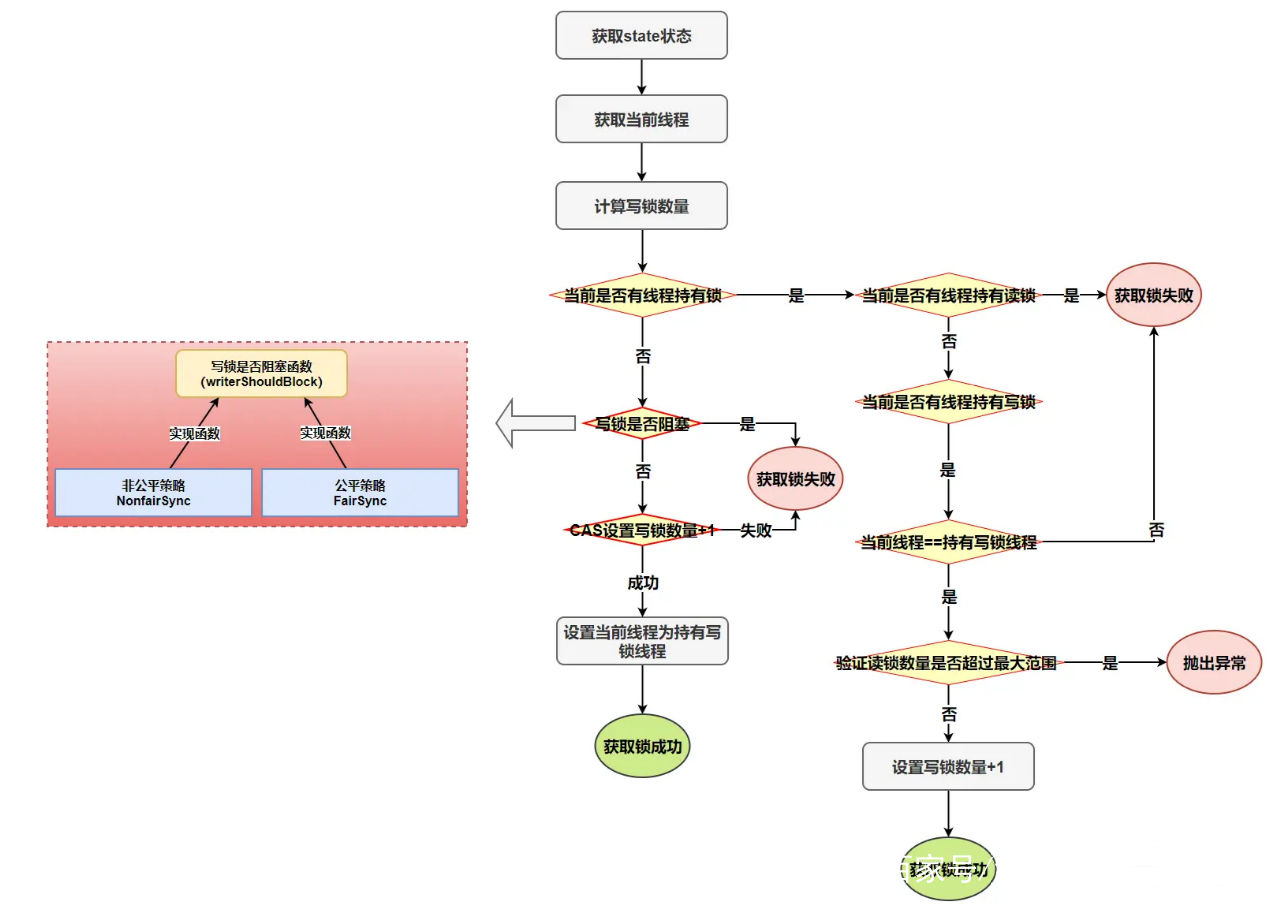
写锁的获取是通过重写AQS中的tryAcquire方法实现的。
writeLock.lock()
用于获取写锁的方法。该方法会阻塞当前线程直到获取到写锁。
当一个线程获取到写锁时,其他线程无法获取到读锁或写锁,直到当前线程释放该写锁。这意味着写锁的获取是独占的,一次只能有一个线程获得写锁。
如果当前线程已经持有写锁,那么该方法会增加锁的重入次数,并立即返回。这允许线程对同一段代码进行多次写操作,而不会被其他线程打断。
注意:在使用ReentrantReadWriteLock时,使用写锁时需要保证不能出现死锁的情况。因为如果一个线程获取到了写锁,其他线程都无法获得锁,如果该线程又尝试获取读锁,则会造成死锁。因此,在使用该锁时需要格外小心,避免出现死锁情况。
ReentrantReadWriteLock内部类WriteLock的lock方法
/*** Acquires the write lock.** <p>Acquires the write lock if neither the read nor write lock* are held by another thread* and returns immediately, setting the write lock hold count to* one.** <p>If the current thread already holds the write lock then the* hold count is incremented by one and the method returns* immediately.** <p>If the lock is held by another thread then the current* thread becomes disabled for thread scheduling purposes and* lies dormant until the write lock has been acquired, at which* time the write lock hold count is set to one.*/public void lock() {sync.acquire(1);}
acquire
获取锁,调用aqs中的acquire方法
/*** Acquires in exclusive mode, ignoring interrupts. Implemented* by invoking at least once {@link #tryAcquire},* returning on success. Otherwise the thread is queued, possibly* repeatedly blocking and unblocking, invoking {@link* #tryAcquire} until success. This method can be used* to implement method {@link Lock#lock}.** @param arg the acquire argument. This value is conveyed to* {@link #tryAcquire} but is otherwise uninterpreted and* can represent anything you like.*/public final void acquire(int arg) {//尝试获取锁if (!tryAcquire(arg) &&//addWaiter:将线程封装到 Node 节点并添加到队列尾部//acquireQueued查看当前排队的 Node 是否在队列的前面,如果在前面,尝试获取锁资源。如果没在前面,线程进入到阻塞状态。acquireQueued(addWaiter(Node.EXCLUSIVE), arg))//中断当前线程,唤醒selfInterrupt();}
tryAcquire
尝试获取锁,ReentrantReadWriteLock内部类sync重写了aqs的tryAcquire方法
protected final boolean tryAcquire(int acquires) {/** Walkthrough:* 1. If read count nonzero or write count nonzero* and owner is a different thread, fail.* 2. If count would saturate, fail. (This can only* happen if count is already nonzero.)* 3. Otherwise, this thread is eligible for lock if* it is either a reentrant acquire or* queue policy allows it. If so, update state* and set owner.*///当前线程Thread current = Thread.currentThread();//aqs的state值 存在读锁或者写锁,状态就不为0int c = getState();//获取写锁的重入数int w = exclusiveCount(c);//当前同步状态state != 0,说明已经有其他线程获取了读锁或写锁if (c != 0) {// (Note: if c != 0 and w == 0 then shared count != 0)// c!=0 && w==0 表示存在读锁// 当前存在读锁或者写锁已经被其他写线程获取,则写锁获取失败if (w == 0 || current != getExclusiveOwnerThread())return false;//最大可重入次数 超出最大范围 65535if (w + exclusiveCount(acquires) > MAX_COUNT)throw new Error("Maximum lock count exceeded");// Reentrant acquire//同步state状态setState(c + acquires);return true;}// writerShouldBlock有公平与非公平的实现, 非公平返回false,会尝试通过cas加锁//c==0 写锁未被任何线程获取,当前线程是否阻塞或者cas尝试获取锁if (writerShouldBlock() ||!compareAndSetState(c, c + acquires))return false;//获取写锁成功 设置写锁为当前线程所有setExclusiveOwnerThread(current);return true;}
写锁的释放
写锁释放通过重写AQS的tryRelease方法实现
writeLock.unlock()
用于释放当前线程持有的写锁。在调用此方法之前,线程必须已经获得了相应的写锁才能释放。
具体地说,当线程调用此方法时,它会将当前线程持有的写锁的计数器减1。如果计数器减为0,则表示当前线程已经完全释放了写锁,其他线程可以获得写锁进行写操作。如果计数器减为负数,则表示当前线程没有完全释放写锁,还有其他线程持有写锁,则会抛出IllegalMonitorStateException异常。
需要注意的是,如果当前线程没有持有写锁,调用此方法会抛出IllegalMonitorStateException异常。因此,在调用此方法之前,必须确保当前线程已经获得了相应的写锁
/*** Attempts to release this lock.** <p>If the current thread is the holder of this lock then* the hold count is decremented. If the hold count is now* zero then the lock is released. If the current thread is* not the holder of this lock then {@link* IllegalMonitorStateException} is thrown.** @throws IllegalMonitorStateException if the current thread does not* hold this lock*/public void unlock() {sync.release(1);}
release
释放锁,调用aqs中的release方法
/*** Releases in exclusive mode. Implemented by unblocking one or* more threads if {@link #tryRelease} returns true.* This method can be used to implement method {@link Lock#unlock}.** @param arg the release argument. This value is conveyed to* {@link #tryRelease} but is otherwise uninterpreted and* can represent anything you like.* @return the value returned from {@link #tryRelease}* release利用tryRelease先进行释放锁,tryRealse是由子类实现的方法,可以确保线程是获取到锁的,并进行释放锁,* unparkSuccessor主要是利用LockSupport.unpark唤醒线程;*/public final boolean release(int arg) {//尝试释放锁,这个方法是由子类实现的方法if (tryRelease(arg)) {Node h = head;//头节点不为如果节点状态不是CANCELLED,也就是线程没有被取消,也就是不为0的,就进行唤醒if (h != null && h.waitStatus != 0)//唤醒线程unparkSuccessor(h);return true;}return false;}
tryRelease
尝试释放锁,ReentrantReadWriteLock内部类sync重写了aqs的tryRelease方法
/** Note that tryRelease and tryAcquire can be called by* Conditions. So it is possible that their arguments contain* both read and write holds that are all released during a* condition wait and re-established in tryAcquire.*/protected final boolean tryRelease(int releases) {//若锁的持有者不是当前线程,抛出异常if (!isHeldExclusively())throw new IllegalMonitorStateException();//state的预期值int nextc = getState() - releases;//当前写状态是否为0,为0则释放写锁boolean free = exclusiveCount(nextc) == 0;//当前写状态为0if (free)//设置锁的持有者为nullsetExclusiveOwnerThread(null);//同步状态statesetState(nextc);return free;}
读锁的获取
实现共享式同步组件的同步语义需要通过重写AQS的tryAcquireShared方法和tryReleaseShared方法。
readLock.lock()
获取读锁的方法。当调用这个方法时,如果当前并没有线程持有写锁,则当前线程可以获取读锁,并允许其它读线程同时获取锁并读取数据。但如果已有一个线程持有写锁,则所有的读线程都将阻塞,直到写锁被释放。
在获取了读锁之后,需要在合适的时候释放它,以避免出现死锁。
/*** Acquires the read lock.** <p>Acquires the read lock if the write lock is not held by* another thread and returns immediately.** <p>If the write lock is held by another thread then* the current thread becomes disabled for thread scheduling* purposes and lies dormant until the read lock has been acquired.*/public void lock() {sync.acquireShared(1);}
acquireShared
aqs中的acquireShared方法
获取共享锁。它的实现方式是通过CAS(Compare And Set)原子操作来实现的,在获取锁之前会先判断当前线程是否可以获取锁,如果不能获取,则会将当前线程加入到等待队列中,并将其阻塞。
/*** Acquires in shared mode, ignoring interrupts. Implemented by* first invoking at least once {@link #tryAcquireShared},* returning on success. Otherwise the thread is queued, possibly* repeatedly blocking and unblocking, invoking {@link* #tryAcquireShared} until success.** @param arg the acquire argument. This value is conveyed to* {@link #tryAcquireShared} but is otherwise uninterpreted* and can represent anything you like.*/public final void acquireShared(int arg) {//尝试获取锁if (tryAcquireShared(arg) < 0)//获取锁失败则加入队列,自旋获取锁doAcquireShared(arg);}
tryAcquireShared
ReentrantReadWriteLock内部类sync重写了aqs的
tryAcquireShared方法是用来尝试获取读锁的方法。读锁是共享锁,多个线程可以同时获取读锁,但是当有一个线程获取写锁时,其他线程不能获取读锁。
tryAcquireShared方法的实现如下:
首先,判断当前线程是否已经获取了写锁,如果是,则可以直接获取读锁,增加读锁的计数并返回。
如果当前没有获取写锁,那么就需要检查是否有其他线程正在获取写锁,如果是,则不能获取读锁,返回负数。
如果当前既没有获取写锁,也没有其他线程在获取写锁,那么就可以尝试获取读锁了。首先获取读锁的计数值,如果当前读锁的计数为0,则可以直接获取读锁,增加读锁计数并返回。否则,判断当前线程是否是最后一个持有读锁的线程,如果是,则可以直接获取读锁,增加读锁计数并返回。否则,不能获取读锁,返回负数。
总的来说,tryAcquireShared方法的实现就是先判断是否有写锁,如果没有则尝试获取读锁,如果其他线程正在获取写锁,则不能获取读锁,否则等待。
protected final int tryAcquireShared(int unused) {/** Walkthrough:* 1. If write lock held by another thread, fail.* 2. Otherwise, this thread is eligible for* lock wrt state, so ask if it should block* because of queue policy. If not, try* to grant by CASing state and updating count.* Note that step does not check for reentrant* acquires, which is postponed to full version* to avoid having to check hold count in* the more typical non-reentrant case.* 3. If step 2 fails either because thread* apparently not eligible or CAS fails or count* saturated, chain to version with full retry loop.*/Thread current = Thread.currentThread();//获取aqs中的状态码stateint c = getState();// 如果写锁已经被获取并且获取写锁的线程不是当前线程,当前线程获取读锁失败返回-1 判断锁降级if (exclusiveCount(c) != 0 &&getExclusiveOwnerThread() != current)return -1;//读锁的数量int r = sharedCount(c);//获取读锁的线程是否该被阻塞if (!readerShouldBlock() &&r < MAX_COUNT &&compareAndSetState(c, c + SHARED_UNIT)) {//当前线程获取读锁//如果是第一个获取读锁的线程,则使用firstReader记录第一个获取读锁的线程对象,并设置第一个获取读锁的线程的重入次数firstReaderHoldCount为1。if (r == 0) {firstReader = current;firstReaderHoldCount = 1;//设置第一个获取读锁线程的重入数// 表示第一个获取读锁的线程重入} else if (firstReader == current) {//第一个获取读锁的线程重入次数+ 1firstReaderHoldCount++;} else {// 非第一个获取读锁的线程// 获取上一次获取读锁的线程的相关记录(上次获取读锁的线程的id和重入次数)HoldCounter rh = cachedHoldCounter;// 如果没有上一个获取获取读锁的线程的信息(第一个获取读锁的线程不算)||上一个获取读锁的线程id不等于当前的线程的idif (rh == null || rh.tid != getThreadId(current))// 从TreadLocal中获取当前线程的信息(重入信息),将上次获取读锁的线程信息设置为当前获取读锁的线程信息。cachedHoldCounter = rh = readHolds.get();else if (rh.count == 0)readHolds.set(rh);//记录其他获取读锁的线程的重入次数rh.count++;}return 1;}//尝试通过自旋的方式获取读锁,实现了重入逻辑return fullTryAcquireShared(current);}
读锁的释放
获取到读锁,执行完临界区后,要记得释放读锁(如果重入多次要释放对应的次数),不然会阻塞其他线程的写操作。
读锁释放的实现主要通过方法tryReleaseShared
readLock.unlock()
释放当前线程持有的读锁。如果当前线程没有持有读锁,则该方法不执行任何操作。
/*** Attempts to release this lock.** <p>If the number of readers is now zero then the lock* is made available for write lock attempts.*/public void unlock() {sync.releaseShared(1);}
releaseShared
释放共享锁,aqs中的releaseShared方法
/*** Releases in shared mode. Implemented by unblocking one or more* threads if {@link #tryReleaseShared} returns true.** @param arg the release argument. This value is conveyed to* {@link #tryReleaseShared} but is otherwise uninterpreted* and can represent anything you like.* @return the value returned from {@link #tryReleaseShared}* 共享模式下的释放。如果『tryReleaseShared』返回true的话,会使一个或多个线程重新启动*/public final boolean releaseShared(int arg) {if (tryReleaseShared(arg)) {doReleaseShared();return true;}return false;}
tryReleaseShared
ReentrantReadWriteLock内部类sync重写了aqs的
tryReleaseShared方法首先获取当前线程。如果当前线程是第一个读取器(即firstReader),则将其移除。否则,将当前线程的读取计数器减1。接下来,使用自旋来减少共享锁的状态,直到成功减少到0。最后,返回是否成功释放了共享锁。
protected final boolean tryReleaseShared(int unused) {Thread current = Thread.currentThread();//当前线程是第一个获取读锁的线程if (firstReader == current) {// assert firstReaderHoldCount > 0;// 第一个获取读锁的线程的重入次数为1if (firstReaderHoldCount == 1)//第一个获取对锁的线程为nullfirstReader = null;else//重入次数大于1,重入次数-1firstReaderHoldCount--;} else {//不是第一个获取读锁的线程HoldCounter rh = cachedHoldCounter;if (rh == null || rh.tid != getThreadId(current))//获取线程的计数器rh = readHolds.get();//重入次数int count = rh.count;//重入次数小于等于1 ,移除该线程的读锁if (count <= 1) {readHolds.remove();if (count <= 0)throw unmatchedUnlockException();}//重入次数大于1,计数器减1--rh.count;}for (;;) {int c = getState();int nextc = c - SHARED_UNIT;if (compareAndSetState(c, nextc))// Releasing the read lock has no effect on readers,// but it may allow waiting writers to proceed if// both read and write locks are now free.return nextc == 0;}}
